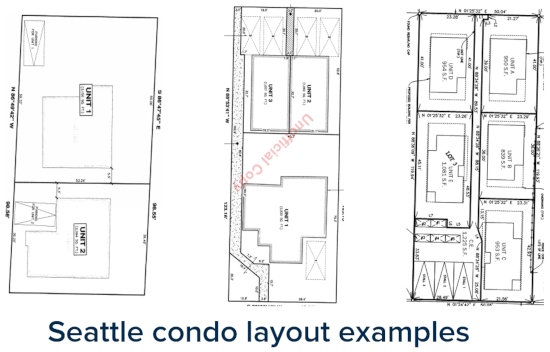Higher-density housing is happening in our state and quite possibly right in your own backyard. This is called middle housing. Middle housing is a term for buildings that are compatible in scale, form, and character with detached single-family houses. In 2023, House Bill 1110 was passed in a bipartisan 35-14 vote in the Senate and 79-18 vote in the House, and is likely to affect most homeowners and purchasers by the summer of 2025 when state law requires local municipalities to enact changes to their local codes. The state’s intention behind HB 1110 is to help provide more affordable housing options in the wake of the Washington State housing affordability crisis, which in turn, creates more density. It has been over a year since this was enacted and municipalities are starting to process and absorb these changes, and middle housing is coming to life.
Some items to consider are listed below:
- Cities with more than 75k people must allow 4 units per lot; they must allow 6 units if within a quarter mile of a (major) transit stop, among other rules.
- Cities between 25k-75k must allow 2 units per lot, among other rules.
- Cities with fewer than 25k have to allow 2 units per lot.
- Cities may not enact standards for middle housing that are more restrictive than for single-family housing.
- Cities may not require off-street parking as a condition of permitting.
Putting political opinions aside, we want to help bring understanding to this option for homeowners and potential homebuyers. The call for higher density has allowed for some properties to be condominium-ized (creating units) vs. subdivided lots in order to add Accessory Dwelling Units (ADU). This is a much simpler process that can be done on smaller-sized properties vs. the larger lot requirements of subdivision. These ADUs can either be attached (AADU) or detached (DADU) and it depends on the size of the property and the location. Here is an example of what one could look like in the City of Seattle.

The City of Seattle has building guidelines that align with creating this density more easily via smaller building setbacks and tax requirements. Other cities have more restrictive requirements, it is location-dependent on how this will play out. Additionally, if a neighborhood has Covenants, Conditions, and Restrictions (CC&Rs) that were recorded before HB 1110 went into effect that prohibit ADUs, then this development will not be allowed despite the legislative change. Assessing this development potential starts with researching CC&Rs (if applicable) and inquiring with the city and/or county planning department where the property is located.
If a property is eligible for this type of growth, getting the condominium approved is a rather quick task. The condo map and declaration need to be drafted and recorded to be official and can take anywhere from 6-10 weeks depending on the responsiveness and availability of a qualified surveyor. The map will address the number of units, where they are located, Common Elements, and Limited Common Elements. The total cost for creating and recording these documents hovers around $10,000 and requires the services of a surveyor and experienced attorney.
If a homeowner is not ready to execute these plans right away, that is OK. They can stop at the recording step and would be grandfathered in to execute these plans in the future even if the municipality changes its building requirements down the road. Of course, many more details are involved, and hiring experts to help navigate the creation of these documents and development is key. Some homeowners are taking the step to create a condominium on their property to expand profitability when they go to sell, and some want to create multi-generational housing options for their families.
The point of this information is to elevate the awareness around these housing options and for homeowners to understand how to maximize the potential of their asset. It should also provide hope for some home buyers who think they are priced out of the market knowing that more of these housing opportunities are coming. If you are curious or have specific questions related to middle housing, please reach out. We have access to experts in the field who we can connect you with, so you can obtain accurate information. As always, it is our goal to help keep our clients well-informed and empower strong decisions.
 Facebook
Facebook
 X
X
 Pinterest
Pinterest
 Copy Link
Copy Link
